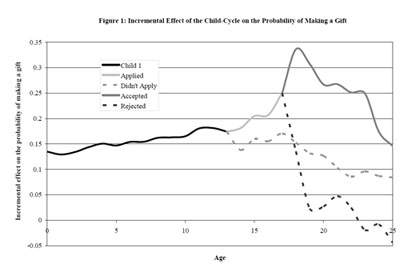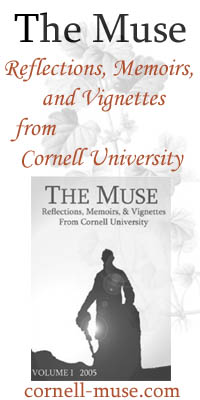 | ||
Archives
|
June 2007
Milstein Hall: Continuously Over Budget?
Here’s a little something that slipped past us in last week’s analysis of Cornell’s financial plan for the 2007-2008 academic year: Milstein Hall is now slated to cost the College of Architecture, Art, and Planning $49 million dollars. That’s a lot of money. Loyal readers, no doubt, will recall that when Rem Koolhaas’s “miracle box” design was released last fall, Milstein Hall was expected to cost $40 million dollars. Unless there are other costs associated with the building that weren't announced at the time, this represented close to a 25% cost overrun. This is not to mention the fact that when Milstein Hall was first announced… way back when… it was billed as a $25 million dollar investment when it was first designed by Steven Holl architects. So now Milstein Hall is apparently 200% over its original budget, and the ground hasn’t even been broken yet. It’s approaching Duffield Hall-esque costs, but I sense that society will get a lot more worth out of nanotech research than architects, no matter how many awards a building may get. The Daily Sun ran a clairvoyant editorial on the topic this past winter, hoping “Cornell will stop wasting time and money and focus on the true point of Milstein — giving AAP students much-needed workspace” while noting that the Koolhaas plan still needs to be “revised and must still go through several planning stages.” This all begs the question: Wasn’t one of the primary reasons behind Hunter Rawlings’s planned dissolution of the College of Art, Architecture, and Planning in 2002 the fact that the college was unable to follow any sort of budgetary guidelines? And what makes us think that AAP is better able to do this now, in 2007? Anybody want to place odds on the probability that Koolhaas’s version of Milstein Hall actually gets built? Late Update: The odds are quite low, apparently. An anonymous tipster writes in to inform us that Milstein's current design is 'infeasible' as it encroaches upon University Avenue, a non-Cornell street. Apparently the City of Ithaca's planning board is also not enthused by the fact that Cornell did not approach them first before publicly unveiling the plan. You would think that a college full of planners would have known better... Matthew Nagowski | June 28, 2007 (#) Coming Soon To Ithaca: A Bike Escalator? We are avid bicycle enthusiasts at MetaEzra. So we were eager to see the bicycle-centric plans stemming out of the transportation planning study for Cornell and Ithaca. This nifty map shows an exhaustive list of all existing and possible bike trails in the City of Ithaca. We were a bit chagrined, however, to notice a rather odd feature proposed for Seneca Street leading up from the Commons to East Hill: A bike escalator. What the hell is a bike escalator? Behold the power of a simple Google Search and YouTube: During the summer I lived in Ithaca, I would play ultimate down on Cass Park twice a week, biking from my lower Collegetown apartment. The commute there was a piece of cake: I could coast half way there from the momentum I gained from the hill. But the ride back, up the hill, with legs already tired from all of the running, was a completely different story. This would have made a big difference. Matthew Nagowski | June 26, 2007 (#) 2007-2008 Cornell Budget: More Money For Financial Aid The 2007-2008 financial plan for the University has been released, and as usual, it is full of all sorts of juicy information about what Cornell is planning to due in the coming years. The document is available here, and includes a rather nice feature article on the history and future of Cornell’s faculty. Perhaps most importantly from MetaEzra’s perspective, the University anticipates spending an additional $9 million dollars on financial aid for students in 2007-2008 academic year. It’s unclear how much of this will be allocated to undergraduates, but I suspect they will comprise the vast majority of the recipients. Keep in mind that the Cornell Alumni Magazine claims that it would cost an additional $17 million to match Harvard’s aid program. Other highlights from the 2007-2008 financial plan include: - The College of Human Ecology is preparing to offer a Masters in Public Policy; how this will compete or overlap with the Masters in Public Affairs offered by the Cornell Institute for Public Affairs (CIPA) is unknown. - The College of Human Ecology is also planning to spend $150 million over the next ten years to create a physical campus that will “both reflect and foster the innovative, multidisciplinary approach that distinguishes the research, academics, and outreach of both the college and Cornell.” - There is $1.6 billion planned for capital investment on the Ithaca campus over the next ten years, of which roughly $450 million has yet to be raised. New York State will pay for roughly $400 million dollars of this construction. - After stagnating for a couple of years, New York State has increased its annual appropriations to Cornell by $16 million to $174 million. The importance of New York State funding to Cornell cannot be understated. To put the increased funding in perspective, it is the equivalent to an additional $320 million dollars in endowment. All said, Cornell’s funding from the State of New York would be the equivalent of an additional $3.5 billion dollars in endowment. Matthew Nagowski | June 19, 2007 (#) Why Legacies Are Given Preference It’s long been acknowledged that under-represented minorities, athletes, and alumni children are given preference in the admissions game at top colleges and universities. But it has never been clearly documented just how much institutions benefit by accepting the sons and daughters of their alumni. A new paper by economists at Princeton and Stanford sheds some light on the role that legacy admits has on alumni giving. Mining over 30 years of data from a prestigious, private four-year undergraduate college (Princeton, I suspect), the authors take into consideration such factors as the undergraduate record of the alum, his or her current occupation, and whether or not they have a graduate degree. And the results are striking.  In the year following the rejection of an alumnus’s child, the probability that the alum will donate money drops by close to 25 percentage points. And if the child is accepted? The probability increases by 10 percentage points. So the lessons to an admissions committee should be fairly obvious. If you are on the fence between deciding to accept a “legacy” admit or an equally qualified candidate with no connections to the school, take the legacy admit every time. The director of alumni affairs and development will thank you for it. Matthew Nagowski | June 15, 2007 (#) Weill Cornell to Get $400 Million, Ithaca $50 Million The capital campaign just got close to a half a billion dollar infusion. Sadly, MetaEzra doens't have the scoop on this one. But the New York Times does: The medical school, based in Manhattan, will use the money for research into and treatment of obesity, diabetes, cancer and the diseases of aging, especially Alzheimer's, which carries a special poignancy for Mr. Weill. His mother died of the disease more than 10 years ago. With the latest gift and $250 million in other donations since October, the medical school is halfway to its goal of raising $1.3 billion by 2011. The Weills are contributing $250 million of the $400 million donation. Corinne and Maurice R. Greenberg are giving $25 million, and their charity, the Starr Foundation, is giving another $25 million. A donor who does not wish to be named is giving $100 million... The Weills previously donated $200 million to Cornell’s medical school, which changed its name in their honor in 1998. Mr. and Mrs. Weill are also giving an additional $50 million today to Cornell University, Mr. Weill’s alma mater, to help pay for research in genomics and other life sciences. Mr. Weill, whose father was a dressmaker and whose mother was a bookkeeper, said all of his gifts to Cornell added up to “a fourth or a third of my net worth, something like that.” Well, at least Ithaca got something... Update: This Weill Cornell press release contains all the details. Interestingly, even though Ithaca's $50 million gift is vastly overshadowed by the $400 million for Weill Cornell, it still represents the largest gift ever given to the Ithaca campus by an individual. Some more: * State-of-the-art facilities, including a proposed Biomedical Research Building, to be built on East 69th Street, giving researchers and scientists the cutting-edge tools and increased space for accelerated innovation and biomedical discovery. Labs will be designed in an open-floor layout, fostering communication and collaboration among scientists and creating synergies for translational research. As the first new research facility built on the Weill Cornell campus in two decades, it will keep New York City at the epicenter of biomedical research. Matthew Nagowski | June 13, 2007 (#) Shock! Common App Increases Apps, Lowers Yield A new study published by economists at the Cornell Higher Education Research Institute reveals what MetaEzra has been asserting all along: Cornell’s adoption of the common application since the fall of 2004 is a large factor in explaining why Cornell’s applications have skyrocketed and yield rates have fallen over the last three years. The paper reveals that, on average, a school that adopts the common application can expect a 6-7 percent increase in its applications received, and a corresponding 2-3 percent drop in its admissions rate. Of course, a school of Cornell’s caliber should probably expect an even larger effect from adopting the common application due to its perceived desirability. Compound this factor with the fact that increasingly more students are applying for increasingly more schools, and the end result is a large spike in applications, as seen between 2004 and 2005 in these data from the Cornell Factbook: Granted, other things like pretty websites and improving Cornell’s “image” matter as well. But the single most important factor explaining Cornell’s admissions numbers over the last three years is the adoption of the Common Application combined with pure demographic trends. And we’ll take the time to reiterate that admissions numbers really don’t tell us much about student quality… and the evidence suggests that the overall academic quality of the student body hasn’t improved much amid a more “competitive” admissions environment. Matthew Nagowski | June 06, 2007 (#) Making Sense of the Lacrosse Season It's been ten days since the lacrosse team suffered its tragic defeat to Duke in the national semifinals, and since then Cornellians far and wide have been trying to make sense of what still turned out to be an extremely rewarding season. And they all do it better than I can. Matt Hintsa has a great time-lapse graph of scoring in the Duke game, and mediates: According to today's ESPN2 commentators, I should be happy that Duke won, even if I am a Cornell student, because their men's lacrosse players overcame the greatest adversity and have grown back stronger after being "cut down" last season. Excuse me?... Duke would have reason to be in the spotlight for overcoming adversity, if, say, its entire lacrosse team had contracted malaria while building houses in Africa (a place few on the team would dare venture, judging from the aforementioned evidence). Overcoming the adversity of something as obnoxious as the team's behavior and subsequent court case shouldn't land the team in the national spotlight. Their struggle was dishonorable from the get-go, whether you think the accused players were guilty of rape or not. The dropping of the charges was not an erasure of the fateful March party; only of the rape allegations associated with it. And Sun Senior Editor Michael Mix wrote during his live-blog of the game: Wow, what a game. Cornell has won close games all season, but today was Duke’s day. Zack Greer made an amazing play to catch and shoot, and he should be give credit. But the Red deserve a lot of credit for coming back and tying the game up after being down 10-3. It has been a great season, and it has been great covering this team. Jeff Tambroni has done a great job of building this team full of quality individuals and lacrosse players. They really have made my job a lot easier. It is a tough way to go out, but these players deserve all the accolades that they have gotten. And Cornell fans should feel confident that they have Tambroni at the helm, because he will continue to put good, hard-working teams on the field who will fight for all the ground balls and play with a lot of heart. It has been a great ride, and I hope that all Red fans enjoyed the game today and the entire season. And the rabid fans over at eLynah are already salivating over the prospect of the 2008 season. Here's Hillel Hoffman: In my opinion, goalie and attack are the biggest potential soft spots. McMonagle was a great stopper, but he was even better at the other little stuff, like initiating transition opportunities with quick, accurate outlet passes. I don't know that much about Myers, the transfer from Syracuse, but it wouldn't be fair to expect him be as complete a goalie as McMonagle was. Matthew Nagowski | June 05, 2007 (#) Cornell Capital Campaign: 1.3 Trillion!?! Either Cornell's development office has switched to the continental European system of using commas instead of decimal points, or somebody committed a couple of rather humorous typos over at campaign.cornell.edu.  Or maybe we are just trying to scare our better-endowed peers. Kind of like stuffing a sock down your gym shorts during phys ed. Late Update: As of 10:45 AM, the error has been fixed. The wonders of the internet. We also have received the following correspondence: Mea culpa! It is true we made a regrettable typographical error in this week's posting of campaign progress on our web site. Our progress to date is in fact $1,257.7 million, thanks to the generosity of many Cornellians and friends. I'll admit that I was a little bit torn about making this post, but I found it too amusing not too. In the end, everybody makes mistakes, and I would be the first to point out the numerous grammatical and spelling mistakes on this humble website. And he that cast the first stone... But this all shouldn't stop us from donating to Cornell's capital campaign. Young alumni, especially. Every donation counts, especially when you consider the fact that the cost of a Cornell education is significantly greater than the price tag of tuition, and that our own Cornell education was greatly subsidized by individuals who donated their money and resources before our time. Cornellians of the future depend on us. Matthew Nagowski | June 05, 2007 (#) Hillary's Cornell-Gate? The New Yorker has picked up on a rather amusing Cornell-related nugget that some Hillary Clinton detractors might like to use against her. So let's see: The junior senator from New York gets an agriculture and environmental management expert from her state's land grant university to provide some policy advice. Yep. That's a story. It's amazing that journalists waste their time on such matters. But at least Cornell's land-grant mission got some positive press out of it. Matthew Nagowski | June 04, 2007 (#) |
-- WSJ: Cornell Wins NYC Tech Campus Bid (EBilmes) -- Barrier Update: City Approves Nets (DJost) -- Big Red Cymbal Guy (Nagowski) -- New York Times Survey on Campus Recruiting is Flawed (KScott) -- Barrier Update: Legal precedent suggests City of Ithaca will not be held liable for gorge suicide (DJost) -- Despite MSG Loss, Big Potential for Big Red Hockey (EBilmes) -- City Council Will Vote on Suicide Nets (DJost) -- An Encounter on the Upper East Side (Nagowski) -- Showing Off Your School Spirit (Nagowski) -- Chipotle Ithaca? (KScott) -- Cornell at the ING NYC Marathon (KScott) -- Crossing Over a Fine Line: Commercial Activity on Campus (KScott) -- Milstein's Downfall (Nagowski) -- Can any Cornell-associated organization really be independent of the University? (Nagowski) -- Slope Media Revisited (EBilmes) -- Slope Media Group Approved for Byline Funding (KScott) -- Occupy AEM? (KScott) -- New campus pub to be good for both Greeks and non-Greeks (Nagowski) -- Gagging the Election (Nagowski) -- The Changing Structure of Rush Week (Nagowski) -- Ivy League Humility in the Midwest (EBilmes) -- Of Median Grades and Economics Minors (Nagowski) -- Homecoming Recap (Nagowski) -- My Cornell Bookshelf (Nagowski) -- The Sun's Opinion Section Has Suddenly Gotten Good (Nagowski) -- Remembering the 11th (Nagowski) -- Cornellian Tapped as Top Economic Advisor (Nagowski) -- Cutting Pledging, and the Good Which Comes With It (EBilmes) -- Why Cornell Should Not Close Fall Creek Gorge (Nagowski) -- Welcome to the Class of 2015 (Nagowski)  |